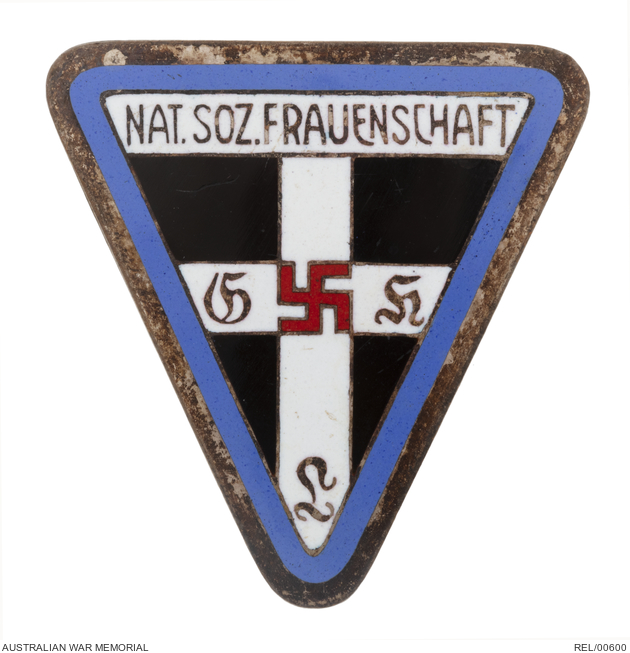| Place | Oceania: Australia, South Australia, Adelaide |
|---|---|
| Accession Number | REL/00600 |
| Collection type | Heraldry |
| Object type | Badge |
| Physical description | Enamel, Metal |
| Place made | Germany |
| Date made | c 1930-1940s |
| Conflict |
Second World War, 1939-1945 |
Professional Leader's N S Frauenschaft (National Socialist Women's League) badge: Mrs P Starke





Enamelled metal triangle lapel badge of the National Socialist Women's League. The design consists of an isosceles triangle on its point, with a narrow outer border of blue enclosing a black centre with a white cross. The centre of the white cross has a red swastika surrounded with the letters G and H in gold and L in black on the left, right and lower arm. A white band across the top of the badge reads 'NAT. SOZ. FRAUENSCHAFT' in gold. Attached to the reverse is a small horizontal pin-back fitting, with embossed letters RZ in a circle and the figures 92 beneath. Scratched beneath the pin on the reverse side is 'P. STARKE'.
This lapel badge was worn by a professional leader member of the Nationalsozialistische Frauenschaft (National Socialist Women's League) the women's wing of the Nazi Party. It was founded in October 1931 and absorbed several national and socialist women's associations in operation at the time such as the Deutscher Frauenorden (German Women’s Order), the Arbeitsgemienschaft Voelkisch Gesinnter Frauen (Association of Racialist Women), and the Rotes Hakenkreuz (Red Swastika).
Little is known about the badge's wartime owner P. Starke, however this item forms part of a large collection of illegal material that was confiscated from enemy aliens and Fascist organisations in Adelaide at the start of the Second World War, which saw a large number of enemy aliens interned in camps throughout Australia. Within 24 hours of the declaration of war, military authorities began to round up enemy aliens in the city, suburbs and the country.
This material was held by the Adelaide Attorney-General's Department for the duration of the war. Decades later, effort was made to reunite the confiscated material with its owner when they could be found, with the remaining material acquired by the Memorial.